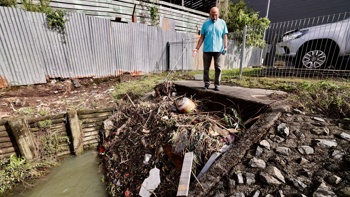WARNING: DISTRESSING CONTENT
For the fourth time since the Philip Polkinghorne murder trial began in July, jurors sat patiently this morning through the CV and introduction of another respected pathologist - this one siding, albeit with caveats, with the defence.
“I would have given the cause of death as hanging,” Dr Christopher Milroy, a University of Ottowa professor who had been a forensic pathologist for over three decades, told jurors via audio-video link from Canada.
His testimony - as the seventh week of the high-profile case got off to a late start - now brings the tally to two Crown pathologists who said there wasn’t enough information to determine whether Pauline Hanna’s neck compression death was suicide or homicide and two defence pathologists who said they reached a non-homicidal hanging conclusion.
Polkinghorne, now 71, is accused of having fatally strangled his wife of 24 years inside their Remuera home before staging the scene on April 5, 2021, to look like a suicide. Prosecutors have presented a circumstantial case focusing on the defendant’s methamphetamine use, his significant spending on sex workers and alleged serious relationship with Sydney escort Madison Ashton, who he traded intimate messages with shortly after his wife’s death.
The defence has argued consistently that Hanna, 63, had struggled with long-term depression, elevated work stress due to her job helping to roll out the Covid-19 vaccine and a documented history of suicidal ideation.
STORY CONTINUES AFTER THE LIVE BLOG
STORY CONTINUES
Milroy, who was made an Officer of the Order of the British Empire earlier this year, said he’s seen roughly 600 to 700 hanging deaths in his career. Although having never before testified in a New Zealand case, he’s visited the country twice for lectures - one time at the invite of one of the Crown witnesses. He was recently tasked with reviewing testimony and reports from Doctors Kilak Kesha and Martin Sage for the Crown and Dr Stephen Cordner for the defence.
Defence lawyer Ron Mansfield KC asked the pathologist almost immediately to referee an opinion from Sage earlier in the trial that defence witness Cordner had gone too far in his finding that Hanna died via non-homicidal hanging.
- Judge issues minute explaining why Polkinghorne trial won't sit today
- Live: Polkinghorne murder trial: Crown attacks expert's suicide finding during cross-examination
- Live: Pathologist says he would have ruled death a suicide; trial to continue for another week
- Polkinghorne defence expert pans Crown's staged suicide theory: 'Mind boggling to imagine'
- Condition of Pauline Hanna’s body consistent with hanging, not strangulation - pathologist
“In my opinion, that is a reasonable opinion to give,” the latest expert said.
Had he been the forensic pathologist in charge of the case, he would have also given the cause of death as hanging with partial suspension, he said. But he added that the standard for determining suicide in Canada is “more likely than not”, a burden of proof often employed in civil cases. Some other jurisdictions, he noted, have a “beyond a reasonable doubt” standard.
“Of course, I’m aware it’s been raised this could be some other form of neck compression with a cover-up, if you like,” he said. “I really would expect, if it was a manual strangulation by throttling, to see external injuries and internal injuries.”
That might especially be the case given Hanna’s age, in which one would expect to see more brittle bones or cartilage, he said.
In all his career, he said, he’s only seen one case in which “the scenario put by the Crown was present” - an attempt to mask the fatal strangling of a 14-year-old as a suicide. But there were multiple injuries that made it “an obvious manual strangulation”, he said.
There was one other case, he said, where a person died of neck compression and there were no injuries. It involved the assailant on top of the victim, who was facedown on the ground and in an armlock. But a factor of that case was the victim was on cocaine, a “risk factor” which might have been an aspect of the death, he told jurors.
“It’s the only case I’ve encountered in my 30-plus years as a forensic pathologist,” he emphasised. “So what we’re talking about are exceedingly rare events.”
Milroy said he didn’t put much weight on the fact Hanna appears to have taken sleeping pills prior to her death. Crown prosecutor Alysha McClintock had painted a theoretical scenario last week, during cross-examination of the other defence pathologist, in which Polkinghorne climbed on his wife’s back as she was sleeping and began to strangle her before she could put up much of a struggle - potentially causing her to pass out within 15 seconds.
“I think you obviously have to take it into account - it’s there,” Milroy said of the drug in Hanna’s system, noting that it might have made Hanna groggy. “But the point is ... that doesn’t mean they’re anaesthetised. They’re going to wake up if something happens to them, and then struggle.”
During cross-examination, McClintock pointed out that alcohol and sleeping pills can “act synergistically to increase the sedative effect”. Milroy agreed but said he wouldn’t go as far as to call it a “double whammy”, as McClintock did.
The prosecutor pointed out that the expert had been mistaken when he assumed his sole example of a neck compression death without injury was the same example that Sage had given jurors as the only case he was personally aware of. Sage’s example involved different circumstances in which there were no witnesses but the aggressor confessed.
“Although the pathology is important, there are other circumstances that come into the question, right?” McClintock asked.
The expert agreed.
“I’m quite aware I’m not the trier of fact,” he said. “The trier of fact is the jury, and they have to put everything together - not just the pathology information... I haven’t heard all the evidence.”
He also acknowledged that while he found the former defence expert’s approach to be objective, fair and scientific, the same could be said for the two Crown pathologists.
McClintock asked again: “You’re not saying pathology is the one source of truth here?”
“No,” he agreed. “Absolutely not.”
But he disagreed that meant the pathology evidence was “neutral”.
The evidence “much more strongly favours suicide over homicide”, he said, adding: “It’s not a 50/50 coin toss.”
Milroy’s testimony was followed by Australian IT expert Atakan Shaho, who was hired by the defence to view the laptops and mobile phones that have been seized by police.
Most of his testimony is expected to take place this afternoon, with the likelihood it will continue into tomorrow, the defence has indicated.
Testimony, before Justice Graham Lang and the jury, is set to resume after the lunch break.
The Herald will be covering the case in a daily podcast, Accused: The Polkinghorne Trial. You can follow the podcast at iHeartRadio, Apple Podcasts, Spotify, through The Front Page feed, or wherever you get your podcasts.
Take your Radio, Podcasts and Music with you









